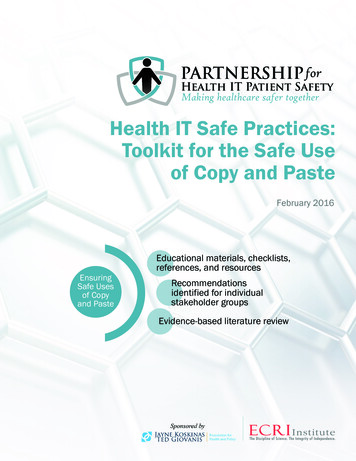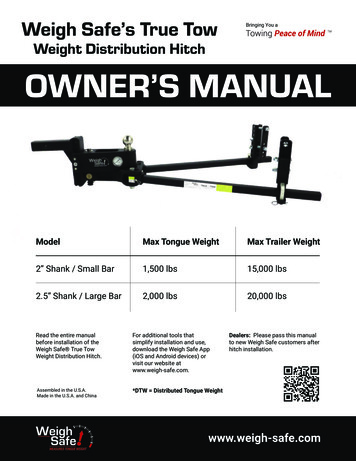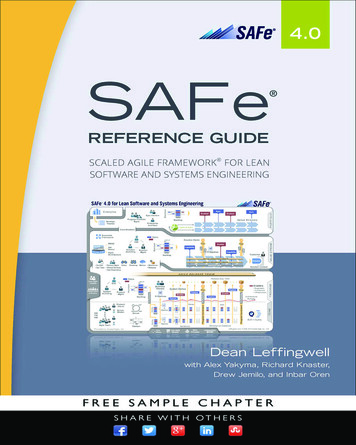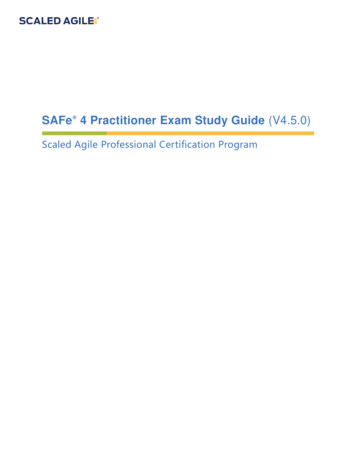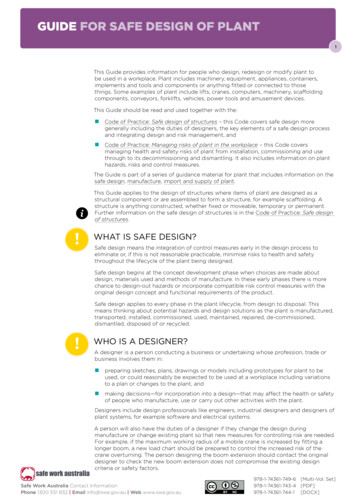
Transcription
GUIDE FOR SAFE DESIGN OF PLANT1This Guide provides information for people who design, redesign or modify plant tobe used in a workplace. Plant includes machinery, equipment, appliances, containers,implements and tools and components or anything fitted or connected to thosethings. Some examples of plant include lifts, cranes, computers, machinery, scaffoldingcomponents, conveyors, forklifts, vehicles, power tools and amusement devices.This Guide should be read and used together with the: Code of Practice: Safe design of structures – this Code covers safe design moregenerally including the duties of designers, the key elements of a safe design processand integrating design and risk management, and Code of Practice: Managing risks of plant in the workplace – this Code coversmanaging health and safety risks of plant from installation, commissioning and usethrough to its decommissioning and dismantling. It also includes information on planthazards, risks and control measures.The Guide is part of a series of guidance material for plant that includes information on thesafe design, manufacture, import and supply of plant.This Guide applies to the design of structures where items of plant are designed as astructural component or are assembled to form a structure, for example scaffolding. Astructure is anything constructed, whether fixed or moveable, temporary or permanent.Further information on the safe design of structures is in the Code of Practice: Safe designof structures.WHAT IS SAFE DESIGN?Safe design means the integration of control measures early in the design process toeliminate or, if this is not reasonable practicable, minimise risks to health and safetythroughout the lifecycle of the plant being designed.Safe design begins at the concept development phase when choices are made aboutdesign, materials used and methods of manufacture. In these early phases there is morechance to design-out hazards or incorporate compatible risk control measures with theoriginal design concept and functional requirements of the product.Safe design applies to every phase in the plant lifecycle, from design to disposal. Thismeans thinking about potential hazards and design solutions as the plant is manufactured,transported, installed, commissioned, used, maintained, repaired, de-commissioned,dismantled, disposed of or recycled.WHO IS A DESIGNER?A designer is a person conducting a business or undertaking whose profession, trade orbusiness involves them in: preparing sketches, plans, drawings or models including prototypes for plant to beused, or could reasonably be expected to be used at a workplace including variationsto a plan or changes to the plant, and making decisions—for incorporation into a design—that may affect the health or safetyof people who manufacture, use or carry out other activities with the plant.Designers include design professionals like engineers, industrial designers and designers ofplant systems, for example software and electrical systems.A person will also have the duties of a designer if they change the design duringmanufacture or change existing plant so that new measures for controlling risk are needed.For example, if the maximum working radius of a mobile crane is increased by fitting alonger boom, a new load chart should be prepared to control the increased risk of thecrane overturning. The person designing the boom extension should contact the originaldesigner to check the new boom extension does not compromise the existing designcriteria or safety factors.Safe Work Australia Contact InformationPhone 1300 551 832 Email info@swa.gov.au Web www.swa.gov.au978-1-74361-749-6 [Multi-Vol. Set]978-1-74361-743-4 [PDF]978-1-74361-744-1 [DOCX]
GUIDE FOR SAFE DESIGN OF PLANT2WHAT HEALTH AND SAFETY DUTIES DO PLANTDESIGNERS HAVE?A designer must ensure, so far as is reasonably practicable, plant is designed without risks tohealth and safety throughout the plant’s whole lifecycle.Risks to health and safety may exist throughout the lifecycle of the plant from manufacturingthrough to installing, commissioning, using, maintaining, repairing, decommissioning anddisposing of the plant. There are often a number of people involved with plant during itslifecycle. A person conducting a business or undertaking can have more than one duty andmore than one person can have the same duty at the same time. For example, sometimes aplant manufacturer, importer or supplier will also have the duties of a designer.Providing and obtaining informationDesigners have obligations to provide information about plant so other duty holders can fulfiltheir responsibility to manage risks and plant users are protected from risks to health andsafety.Information must be passed on from the designer through to the manufacturer, importer,supplier and the end user. This information includes: the purpose for which plant was designed (the intended use) the results of calculations, analysis, testing or examination necessary to use, inspect,commission and maintain plant safely details about plant design registration, if applicable, and any conditions necessary for the plant to be used safely.It is also helpful for designers to provide information on the relevant technical standards usedin the plant’s design so the plant can be manufactured, installed and used in accordance withthose standards.Information should be easily understood by the person receiving it. Information may be acombination of writing or visual information like drawings, signs, symbols, diagrams or videos.Where visual information is provided it should meet the relevant standard.The designer should record details of testing and examination carried out and must ensurethey are made available to the design verifier if plant design registration is required. Forexample, if plant is required to be located a specific distance from other plant writteninstructions must be provided for the manufacturer, supplier, installer, owner and end user.Information flow between the designer and manufacturerDesigners must provide specific information to the manufacturer to enable the plant to bemanufactured in accordance with the design specifications. If relevant, information must beprovided on: installing, commissioning, using, handling, storing, decommissioning and dismantling theplant hazards and risks associated with using the plant testing or inspections to be carried out systems of work and competency of users necessary for the plant to be used safely, and emergency procedures if there is a malfunction.If the manufacturer tells the designer there are safety issues with the design, the designermust revise the information to take account of these concerns, or tell the manufacturer inwriting the reasons why revisions are not necessary.Designer information that can be provided to the manufacturer is in Table 1.JULY 2014
GUIDE FOR SAFE DESIGN OF PLANT3Table 1 Designer information that should be provided to the manufacturerDesigner information that can be provided to the manufacturerManufacturing plant specific conditions relating to the method of manufacture instructions for fitting or refitting plant parts and their location onother components of the plant or their housings where errors couldbe made when installing the plant instruction where hot or cold parts or material may create a hazard specifications of material wiring diagrams specifications for proprietary items e.g. electric motors component specifications including drawings and tolerances assembly drawings assembly procedures including specific tools or equipment to beused manufacturing processes e.g. requirements for welding details of hazards presented by materials during manufacturing, and safety outcomes for programming.Transporting, handlingand storing plant dimensions and weight handling instructions e.g. application points for lifting equipment, and conditions for storage.Installing andcommissioning plant exposure to dangerous parts before installing guards lifting procedures plant interacting with people plant interacting with other plant e.g. connected services andinstallations stability during installation the proposed method for installing and commissioning including teststhat should be carried out using special tools, jigs, fixtures and appliances necessary to minimisethe risk of injury during installation concealed installations e.g. gas or fuel lines, and environmental factors affecting installation and commissioning.Using, inspecting andtesting plant intended uses for the plant including prohibited uses operating procedures safe entry and exit requirements for maintenance and repair e.g. nature and frequency ofmaintenance, disposal of hazardous by-product and consumables emergency situations e.g. types of firefighting equipment exposure to hazardous chemicals how environmental conditions effect using the plant the results or documentation of tests and examinations carried out onthe plant and design de-commissioning, dismantling and disposing of plant known residual risks i.e. those that cannot be eliminated or sufficientlyminimised by designJULY 2014
GUIDE FOR SAFE DESIGN OF PLANT4Designer information that can be provided to the manufacturer details of control measures e.g. personal protective equipment (PPE)to further minimise the risks associated with plant information on administrative control measures, and requirements for special tools needed to use or maintain plant.Design verification and registrationThe Work Health and Safety (WHS) Regulations lists the plant that requires design registrationbefore the plant can be supplied (registrable plant). For registrable plant, the information tobe provided by the designer to the manufacturer should include the plant design registrationnumber. This provides evidence the plant design has been registered under the WHSRegulations. The plant design registration number is not necessary where the manufacturingprocess relates to the development of a prototype to test the design.To register a plant design it must be verified by a design verifier who must provide a statementthat the design is in accordance with published technical standards or engineering principlesnominated by the designer. The statement must: include the design be in writing and signed by the design verifier and include their name and businessaddress have drawings or other documents capable of being kept in electronic form, and if applicable, also include the design verifier’s qualifications and the name and businessaddress of the organisation for which the design verifier works.Design verifierA design can only be verified by a person who is eligible to be a design verifier under theWHS Regulations. People who are competent to verify the design of plant include those who: have educational or vocational qualifications in an engineering discipline relevant to thedesign to be verified, or have knowledge of the technical standards relevant to the design to be verified, or have the skills necessary to independently verify the design was produced in accordancewith the published technical standards and engineering principles used in the design, or are certified by a body accredited or approved by the Joint Accreditation System—Australia and New Zealand or an equivalent overseas body to carry out conformityassessments of the design against the relevant technical standards.For example, a person accredited by a third party certifier may have the qualifications andexperience to be a design verifier for a particular type of plant.Similarly, a design verifier could also be someone who is: registered on the National Professional Engineers Register administered by the Institutionof Engineers Australia and is determined by that institution as competent to verify thedesign, or a member of the Institution of Engineers Australia with the status of CharteredProfessional Engineer.The design verifier, who may be in-house or an independent contractor, must not have beeninvolved in the plant design process. However a design verifier may verify more than onedesign at the same time as long as the verifier was not involved in the plant design process.For example, a company designs passenger lifts and vehicle hoists—once a lift design isfinalised a design verifier starts to verify the lift design. Part way through verifying the liftdesign, a new vehicle hoist design is finalised and the company asks the same design verifierto also verify the new vehicle hoist design. This is allowed because the design verifier wasnot involved in either design process and the verifier is only verifying plant designs alreadyJULY 2014
GUIDE FOR SAFE DESIGN OF PLANT5developed. This also applies if the designs are within the same plant category, for exampletwo different passenger lift designs.Where the design verifier is engaged by the person conducting a business or undertaking thatproduced the design that person must have a quality system in place that has been certifiedby a body accredited or approved by the Joint Accreditation System – Australia and NewZealand.DESIGNING PLANT TO CONTROL RISKThe design brief should include a requirement to apply a risk management process in thedesign phase. A systematic approach to integrating design and risk management is describedin Figure 1 below.The safe design of plant is usually a repetitive process. After the initial control measures areincorporated into the design, the design should be reviewed to determine whether there areremaining risks and whether redesign can eliminate or minimise these risks. Various parts ofplant design and risk management process are discussed below.Pre-design and concept development phaseThis phase involves: establishing the intended use of the plant, its functions and limitations identifying the roles and responsibilities for the project and establishing co-operativerelationships with clients, manufacturers and users of the plant including those whomaintain and repair the plant, and researching and consulting to assist in identifying hazards and assessing and controllingrisks.Intended use of plantThe intended use of the plant including its functions and limitations (see Table 2) can bedetermined by looking at: the expected place of use e.g. environment and supporting surfaces intended functions and operating modes safe use requirements including reasonably foreseeable misuse planned service life relevant standards and specifications e.g. what is produced and materials to be used possible malfunctions and faults testing, maintenance and repair requirements the people interacting with the plant, and other products interacting with or related to the plant.Table 2 Examples of plant functions and limitsPlant limitationsExamplesUseIntended use, production rates, cycle times and working load limitsSpaceRange of movement and access for maintenanceTimeWear and tear of materials and use of fluidsEnvironmentTemperature, humidity, noise and locationInterfaceOther plant, energy sources and user interfaceTechnologyIntuitive decision making and visual stimulus overloadJULY 2014
GUIDE FOR SAFE DESIGN OF PLANT6FIGURE 1A systematic approach to integrating design and risk managementJULY 2014
GUIDE FOR SAFE DESIGN OF PLANT7Identifying the hazardsThe first step in the risk management process is to identify all hazards. Hazard identificationshould be done as early as possible in the concept development and design phases. Thisinvolves finding the things and situations that could potentially cause harm to peoplethroughout the plant’s lifecycle and the reasonably foreseeable hazards associated with eachactivity. Hazards relating to plant are often caused by: the plant itself e.g. hazards associated with a forklift could include the plant’s mobility,electrical, hydraulic and mechanical power sources, moving parts, load-carrying capacityand user protection, and how and where the plant is used e.g. forklift hazards may arise from the load being lifted,the size of the area where it is used and the slope or evenness of the ground.Hazards may be identified by looking at the workplace and how work is carried out. It is alsouseful to talk to workers, manufacturers, importers, suppliers and health and safety specialistsand review relevant information, records and incident reports.Table 3 lists things to consider when looking for plant hazards.Table 4 shows examples of potential plant hazards and phases of the plant lifecycle after thedesign has been completed where people might be exposed to plant hazards.Table 3 Things to consider to identify plant hazardsThings to consider to identify plant hazardsHazards Can the plant cause injury from entanglement, crushing, trapping,cutting, stabbing, puncturing, shearing, abrasion, tearing orstretching? Can the plant create hazardous conditions from pressurisedcontent, electricity, noise, radiation, friction, vibration, fire, explosion,temperature, moisture, vapour, gases, dust, ice, hot or cold parts? Can the plant cause injury from lack of guarding of moving parts? Can the plant cause injury as a result of unexpected start-up? Can the plant cause injury or ill health from poor ergonomic design?Suitability Is the plant fit for its intended purpose? What is likely to happen if itis used for a purpose other than the intended purpose? Are the materials used to make the plant suitable? Are plant accessories fit for their intended purpose? Is the plant stable? Could it roll over? If the plant is intended to lift and move people, equipment ormaterials, is it capable of doing this?Access Is access to the plant necessary when installing, using andmaintaining the plant or in an emergency? Can workers access the plant safely without being injured by the plantor the risk of slips, trips and falls e.g. a walkway, gantry, elevated workplatform or fixed ladder?Location Does the plant affect the safety of the area where it will be locatede.g. what is its impact on the design and layout of the workplace? Does the location affect the safety of the plant e.g. environmentalconditions, terrain and work area? Will there be people or other plant nearby? What effect would thishave?JULY 2014
GUIDE FOR SAFE DESIGN OF PLANT8Things to consider to identify plant hazardsSystems ofwork Do the systems of work for the plant create hazards? Does the plant’s safety depend on the competency of its users? Have users and others working near the plant received relevanttraining, information, instruction and supervision needed to ensurethey are safe?Unusualsituations What unusual situations or misuse could occur? What would happen if the plant failed? Would it result in loss ofcontents, loss of load, unintended ejection of work pieces, explosion,fragmentation or collapse of parts? Is it possible for the plant to move or be operated accidently?Table 4 Examples of plant hazards and phases of the plant lifecyclePotential hazardsPhases of the plant lifecycle mechanical e.g. crushing, cutting, manufacturetrapping, shearing and high pressurefluids electrical thermal noise vibration radiation hazardous chemicals slipping, tripping and falling manual handling confined spaces environmental conditions, and hazards resulting from a combinationof the above. storage packing and transportation unloading and unpacking assembly installing commissioning using cleaning and adjustment inspection planned and unplanned maintenanceor repair decommissioning dismantling, and disposal and recycling.Assessing and controlling risksA risk assessment involves considering what could happen if someone is exposed to a hazardand the likelihood of it happening. A risk assessment can be done with varying degrees ofdetail depending on the complexity of the plant and the type of information available. Specificrisk analysis tools and techniques may be needed to assess the different types of plant usedat the workplace.Risk controls are ranked from the highest level of protection and reliability to the lowest. Thisranking is known as the hierarchy of risk controls. Risk controls must effectively eliminatethe risk or, where that is not reasonably practicable, minimise the risk. Elimination is the mosteffective control measure and must always be considered before anything else.Many hazards can be addressed at the design phase. For example, designing machinery toproduce low noise levels is more effective than providing workers with PPE. This also avoidscostly changes to plant after it has been manufactured.If eliminating the risk is not reasonably practicable, you must consider using substitution,isolation or engineering controls, or a combination of these control measures, to minimise therisk. The designer should aim to use higher level controls and avoid administrative controlsand the use of PPE as these are provide the lowest form of control.JULY 2014
GUIDE FOR SAFE DESIGN OF PLANT9Further information on risk assessment and control is in the: Code of Practice: How to manage work health and safety risks, and Code of Practice: Managing the risks of plant in the workplace.Information sources on managing risksThere are a range of information sources to help manage risks associated with plant and thesystems of work used in connection with the plant including: the WHS Act and Regulations, codes of practice and technical standards about designing,manufacturing, testing and using plant injury, faults, incident reports and plant failure data kept by manufacturers and users ofthe same or similar types of plant statistics, hazard alerts or other reports from regulators, unions, employer associations,specialists, professional bodies representing designers, manufacturers, or engineers information and documentation supplied by designers or manufacturers on safety andhealth issues e.g. test reports on previous designs or similar plant, and reports or articles from work health and safety journals, technical references or data bases.Specific information may come from: inspecting failed plant returned by users developing prototypes and inspecting and testing their design and manufacture, and conducting ‘walk-through’ surveys of the workplace where the plant will be used beforebeginning the design process and while the plant is being installed or erected—the latterto look for hazards which may be introduced during installation.Where possible, talk to other plant designers, manufacturers, installers and users. Peopleworking with the same or similar plant are often well aware of what can go wrong andwhy and how the work environment can change. It also enables issues to be discussed, forexample whether it is possible to use alternative design materials for a safer design.Design phaseThe design phase may involve: developing a prototype or initial design testing, trialling or evaluating the prototype or design redesigning to control any remaining risks, so far as is reasonably practicable, and finalising the design and preparing risk control plans for the lifecycle of the product.Some hazards may be addressed by applying existing solutions in published technicalstandards. Alternatively a risk management process should be used to develop and select themost effective control measure. Proven engineering best practice may also be applied if thereare no relevant standards.Technical standardsA plant designer may use technical standards or a combination of standards and engineeringprinciples relevant to the design requirements as long as the design meets regulatoryrequirements. Engineering principles include, for example mathematical or scientificprocedures outlined in an engineering reference or standard.JULY 2014
GUIDE FOR SAFE DESIGN OF PLANT10Testing and examining plantAnalysis, testing or examination that may be necessary to ensure, so far as is reasonablypracticable, that the plant is designed without risks to people’s health and safety must becarried out by the designer. Testing may include developing a prototype to: simulate the normal range of operational capabilities test design features to ensure ‘fail safe’ operation measure imposed stresses on critical components to ensure maximum design stresses arenot exceeded test critical safety features like over-speed and over-pressure devices under both normaland adverse operational conditions, and develop overload testing procedures to ensure plant safety when plant is misused.Records of tests and examinations must be maintained by the designer.SAFE DESIGN CONSIDERATIONSDesigning plant which is safe to useA designer should consider: the required skill levels to use or maintain the plant the complexity of functions a user can be expected to perform the need for and the location of items to ensure proper use and prevent user errors e.g.aids, guides, indicators, guards, mounted instruction, signs, symbols and name plates ensuring plant design is fail safe at least to the category, performance and safety leveldetermined by the plant risk assessment the layout of work stations e.g. the view of work being performed and the position of theworker in relation to plant controls instrumentation needed at each work station or cabin and the layout of theinstrumentation devices, tools or controls the user and support people need to carry out their jobs safely the options available to allow quick recovery or to maintain the safety and integrity of thesystem if the user makes an error or the plant fails whether the user of the plant is accessible if help is needed environmental conditions that may impair user performance e.g. long periods where theuser carries out physical or repetitive activity or inactivity in a hot or cold environment,and separating people including the user from entrapment when using plant e.g. being caughtbetween the plant and other objects in use.Designers should also consider predictable human behaviour and never assume those whouse or maintain plant have a full appreciation of essential safety features. Where user error islikely, higher order control measures should be incorporated into the design.For example, a driver uses a tractor to haul a hydraulically operated tilt-up trailer loaded withgrain. The gear lever of the tractor is positioned close to the control lever which operatedthe tip-up mechanism of the trailer. While underway, the driver’s arm moves the controllever slightly so the trailer tray began to lift. The trailer rises and eventually overturns. If thepossibility of this type of incident occurring had been anticipated at the design phase theselevers would have been located far enough away from each other so the operator did notaccidentally activate the wrong mechanism.For power operated plant with a seat belt, there may be a risk that operators regularly gettingon and off the plant may not wear the seatbelts. If the plant is designed so a seat belt in-usesensing system and the engine are interlocked then the operator will need to use the seat belt.JULY 2014
GUIDE FOR SAFE DESIGN OF PLANT11Physical and intellectual characteristics of usersPlant should be designed to take into account the range of physical characteristics andintellectual ability of likely users. Designers should take into account information aboutthe range of human dimensions and capabilities, for example height, reach and weight,to provide an optimum match between plant and users. Anthropometry—that is humanbody measurement—data should be considered. Designers should consider the varyinganthropometrics of cultural groups likely to use the plant.If information is available on who will be using the plant the designer might also tailor theplant design to meet the needs of specific people.A designer should: apply ergonomic design principles so when the plant is being used properly the user’sdiscomfort, fatigue and psychological stress are minimised, so far as is reasonablypracticable take into account the ability of workers e.g. if people with specific disabilities will use theplant, and consider whether the plant could be misused or how uncontrolled physical movementscould impact the plant’s operation.Minimising human errorHuman error is not always the result of carelessness or negligence. Sometimes the desirefor extra speed, increased production and making tasks easier mean guards are bypassedor removed. Workers may become bored and distracted with repetitious work or use unsafework practices to overcome poor plant design. For example, locating two important operatorcontrols close together which are of similar shape or size may lead to the user mistakenlyoperating the wrong control.Workers have a responsibility to take reasonable care for their own health and safety andmust not adversely affect the health and safety of others. Workers must comply with anyreasonable instruction and co-operate with any reasonable policy or procedure. Workersshould not use unsafe practices or deliberately bypass guarding on plant.Designers should be aware of the factors contributing to human error when designing plantincluding: forgetfulness workers’ conscientiousness to ‘get the job done’ or to ‘find a better way’ capacity to understand information psychological or cultural environment habit accepted practice fatigue, and level of training.Further information on human error is in Appendix A.Reasonably foreseeable misuseSometimes plant may be used for things it was not designed for or originally intended. Forexample, where an excavator is used to lift and transport concrete pipes or when a frontend loader is used as a crane. When designing plant it is helpful for the risk of reasonablyforeseeable misuse to be assessed and acceptable control measures incorporated in thedesign. One way of identifying potential misuse is by
Designers include design professionals like engineers, industrial designers and designers of plant systems, for example software and electrical systems. A person will also have the duties of a designer if they change the design during . manufacturing processes e.g. requirements for welding







